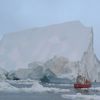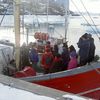21.1.2008 | 18:44
Hefjum landafręši og landfręši-kennslu til viršingar!
Edwards Huijbens samstarfsmašur minn og félagi sendi śt skemmtilega grein eša umfjöllun Guardian į knżjandi žörf fyrir aš hefja upp kennslu ķ landafręši ķ Bandarķkjunum og fleiri löndum.
Ég stenst ekki mįtiš og sendi hana meš. Hśn er nokkuš góš.
This new geography is about far more than scree
There is an urgent need to put this beleaguered subject back in its place as an instrument of national ambitions
Marina Hyde
Saturday January 19, 2008
The Guardian
Which of us did not feel the world had changed beyond measure having read that an Ofsted study has found schoolchildren deem geography "irrelevant" and "boring"? What on earth has happened to geography's insane cool of yore, when a patched-corduroy-jacketed buccaneer would wonder why the word KCID flashed up when he switched on the overhead projector, and turn an exhaustedly blind eye to moderate cider consumption on field trips?
Gone, it seems, along with the ability to identify the capital of Facebook on a map. Understandably, the matter is of much concern to the powers that be, and they promise "radical reforms" to put geography back where it belongs.
Their first step will be to examine how other countries are meeting the challenge, perhaps beginning with a look at the US, where the government appears to be rolling out a hardhitting interactive campaign to raise the profile of geography. In 2003, the country's National Geographic Society conducted a study in which 18- to 24-year-olds were asked to place various countries on a world map. For whatever reasons - not including the US's ongoing romance with xenophobia - a mere 13% could point to Iraq, and 17% to Afghanistan.
Did the US government have some angsty huddle with school inspectors who agreed that "geography was at a crucial period in its development"? No. That's the cheap option. Instead, they sent many thousands of their citizens from this precise age range on an all-expenses-paid field trip to both these countries. I'll bet those youngsters can point at Iraq and Afghanistan now. Well, the ones with arms can. And you know what? They did all this untrammelled by heath and safety regulations. So it's possible, if we put our minds to it.
It was the American writer Ambrose Bierce who once remarked that "War is God's way of teaching Americans geography", and though the Almighty's educative methods can seem a little extreme - is there a Montessori version of them, I wonder? - he definitely hit on the global need to bring a little vim to this potentially dour subject. If this week's Ofsted study has shown us anything, it's that we need a new geography for a new geopolitics, with this column only happy to provide a work book for the teacher no longer willing be pigeonholed as "the scree guy".
There is still a place for field trips in this brave new world, but with the aforementioned pressure of health and safety, you should attempt to combine as many strands of geography as possible in one expedition. Afghanistan is an ideally efficient choice, weaving physical, political and human geography together in spellbinding fashion. Assemble your group pretty much anywhere in this intriguing war park, then explain that this rock formation is called rubble. And what was it before that? Anyone? OK, it was slightly larger rubble left by the Soviets. Before that it might have been an early hospital, but your coursework will only go back to the early 1980s, so you needn't worry about that.
The classroom will, of course, be the hub of your activities, and it is here that you should remind students that maps have always been just a point of view. With the shift from hunter-gathering to agriculture, cartographers no longer focused on hunting trails and prey movement but on field systems and property relations. And so today, where the "level playing field" appearance of the classic world map looks bizarrely antiquated. Encourage the children to divide the world into "places you might like to visit again" and "places suitable for hosting wars". Explain that we do things this way because it's better to take the fight to the terrorists before they bring it to us. Explain this hurriedly - they may spot flaws.
Later in the course, get pupils to draw maps of the world with the scale of countries determined not by physical size but their sense of self-importance. Isn't Britain huge? Use this as the reference map for your classroom wall.
History remains a valuable example of what not to do - and not just because it's "the other humanity". In the 1980s, Saddam Hussein commissioned a globe with all the Arab countries in the world shaded orange and the rest of the world yellow. Look how he ended up. Today's sensitive child should be encouraged by the ancient South Asians, whose preoccupation with cosmology was such that earthly maps were rarely made. Get your pupil to study a map of where all the gazillion dollars we've sent into space have gone, as opposed to one of somewhere we feel a bit awkward about, like Africa.
For homework, set the class relevant questions, such as: what are the politics of GPS? Or: some time after Hurricane Katrina, Google Earth replaced images of devastated areas of New Orleans with pre-Katrina imagery. After complaints, the real pictures were restored, but isn't it nicer to draw a veil over the unsightly? Was cartography the first airbrushing?
In short, tomorrow's radical geography teacher or syllabus-setter must realise that the subject has no limits, only boundaries, whose coordinates are largely disputed. They must, if you'll pardon the relevance, tear up the map.
Meginflokkur: Stjórnmįl og samfélag | Aukaflokkar: Menntun og skóli, Vķsindi og fręši | Facebook


 aloevera
aloevera
 apalsson
apalsson
 axelthor
axelthor
 arnid
arnid
 begga
begga
 birgitta
birgitta
 bjarnimax
bjarnimax
 gattin
gattin
 dofri
dofri
 patent
patent
 killjoker
killjoker
 neytendatalsmadur
neytendatalsmadur
 lucas
lucas
 gudr
gudr
 gudrunvala
gudrunvala
 hrannarb
hrannarb
 ingibjorgelsa
ingibjorgelsa
 ingolfurasgeirjohannesson
ingolfurasgeirjohannesson
 kreppan
kreppan
 jon-o-vilhjalmsson
jon-o-vilhjalmsson
 hugsadu
hugsadu
 larahanna
larahanna
 manisvans
manisvans
 mixa
mixa
 methusalem
methusalem
 mortenl
mortenl
 olijon
olijon
 salvor
salvor
 sigurborgkrhannesdottir
sigurborgkrhannesdottir
 siggi-hrellir
siggi-hrellir
 shv
shv
 steina
steina
 torfusamtokin
torfusamtokin
 toshiki
toshiki
 valgeirskagfjord
valgeirskagfjord
 vefritid
vefritid
 vilberg
vilberg
 villidenni
villidenni
 postdoc
postdoc
 thorrialmennings
thorrialmennings





Bęta viš athugasemd [Innskrįning]
Ekki er lengur hęgt aš skrifa athugasemdir viš fęrsluna, žar sem tķmamörk į athugasemdir eru lišin.